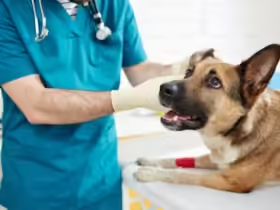The world of veterinary medicine is evolving rapidly, bringing exciting innovations and trends that promise to improve the health and well-being of our canine companions. As technology and science advance, the future of dog medicine looks brighter than ever. In this blog post, we’ll explore some of the most promising developments in dog medicine, including new treatments, diagnostic tools, and preventative measures that are on the horizon.
1. Precision Medicine and Personalized Treatments
One of the most significant advancements in dog medicine is the move towards precision medicine. This approach tailors medical treatments to the individual characteristics of each dog, considering factors like genetics, environment, and lifestyle. Precision medicine aims to provide more effective and targeted therapies, reducing the risk of adverse reactions and improving outcomes.
Key Developments:
- Genetic Testing: Advances in genetic testing are enabling veterinarians to identify breed-specific predispositions to certain health conditions. This allows for earlier intervention and personalized treatment plans.
- Customized Medications: Researchers are developing medications that can be customized based on a dog’s genetic profile, ensuring the most effective treatment with minimal side effects.
2. Telemedicine and Digital Health Tools
Telemedicine is revolutionizing how we access veterinary care, offering convenience and expanded access for pet owners. With the rise of digital health tools, veterinarians can now diagnose and treat dogs remotely, making it easier to manage chronic conditions and provide ongoing care.
Key Developments:
- Virtual Consultations: Pet owners can now schedule video consultations with veterinarians, allowing for real-time assessments and advice without the need for an in-person visit.
- Remote Monitoring Devices: Wearable devices and health trackers are becoming increasingly sophisticated, providing continuous monitoring of a dog’s vital signs and health metrics. This data can be used to adjust treatments and detect issues early.
3. Regenerative Medicine and Stem Cell Therapy
Regenerative medicine is an exciting field that focuses on repairing or replacing damaged tissues and organs. Stem cell therapy, in particular, holds promise for treating a variety of conditions in dogs, including arthritis, ligament injuries, and certain types of cancer.
Key Developments:
- Stem Cell Treatments: Stem cell therapy involves using a dog’s own stem cells to regenerate damaged tissues. This approach has shown promise in improving mobility and reducing pain in dogs with joint issues.
- Platelet-Rich Plasma (PRP) Therapy: PRP therapy uses concentrated platelets from a dog’s blood to promote healing and reduce inflammation. It’s being used to treat conditions such as tendon injuries and osteoarthritis.
4. Advanced Diagnostic Tools and Imaging
The advancement of diagnostic tools and imaging techniques has significantly improved our ability to diagnose and monitor health conditions in dogs. Innovations in this area are leading to earlier detection and more accurate diagnoses.
Key Developments:
- Artificial Intelligence (AI) in Diagnostics: AI algorithms are being used to analyze medical images, such as X-rays and MRIs, with greater accuracy and speed. This helps veterinarians identify abnormalities and make more informed decisions.
- Molecular Diagnostics: Molecular diagnostic tools are enabling veterinarians to detect genetic mutations and pathogens with high precision. This leads to more accurate diagnoses and tailored treatment options.
5. Immunotherapy and Novel Vaccines
Immunotherapy and new vaccine technologies are transforming the way we approach disease prevention and treatment. These innovations aim to enhance the immune system’s ability to fight infections and cancers.
Key Developments:
- Cancer Immunotherapy: Immunotherapy is being explored as a treatment for canine cancers, aiming to harness the power of the immune system to target and destroy cancer cells.
- Therapeutic Vaccines: Researchers are developing vaccines that not only prevent diseases but also treat existing conditions by stimulating the immune system to fight off specific pathogens or cancer cells.
6. Nutritional Science and Functional Foods
Nutrition plays a crucial role in a dog’s overall health, and advancements in nutritional science are leading to the development of functional foods and supplements that address specific health concerns.
Key Developments:
- Specialized Diets: Nutritional science is driving the creation of specialized diets for dogs with conditions such as diabetes, kidney disease, and allergies. These diets are formulated to support health and manage symptoms.
- Probiotics and Supplements: Functional foods and supplements, such as probiotics and omega-3 fatty acids, are being used to support digestive health, reduce inflammation, and improve overall well-being.
7. Ethical Considerations and Welfare
As technology and medicine advance, ethical considerations and animal welfare remain at the forefront. Ensuring that innovations in dog medicine are implemented with the highest ethical standards is crucial.
Key Developments:
- Regulation and Oversight: There is an increasing focus on ensuring that new treatments and technologies undergo rigorous testing and are subject to ethical oversight to protect animal welfare.
- Owner Education: Educating pet owners about the benefits and limitations of new medical advancements is essential for informed decision-making and responsible pet care.
Conclusion
The future of dog medicine is filled with promise, driven by technological advancements and innovative research. From precision medicine and telehealth to regenerative therapies and advanced diagnostics, these trends are set to transform how we care for our canine companions. By staying informed about these developments, pet owners and veterinarians can work together to provide the best possible care and improve the quality of life for dogs everywhere.











Leave a Reply